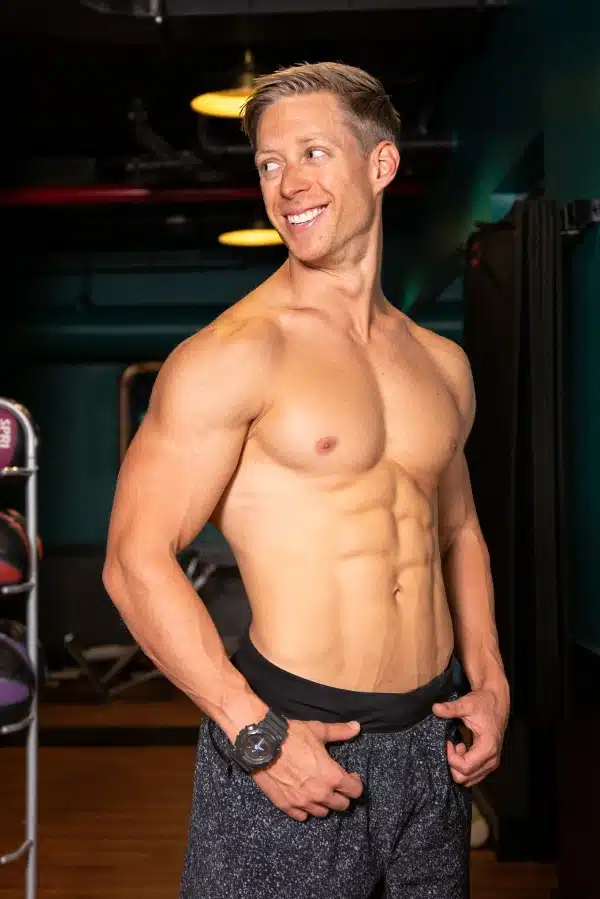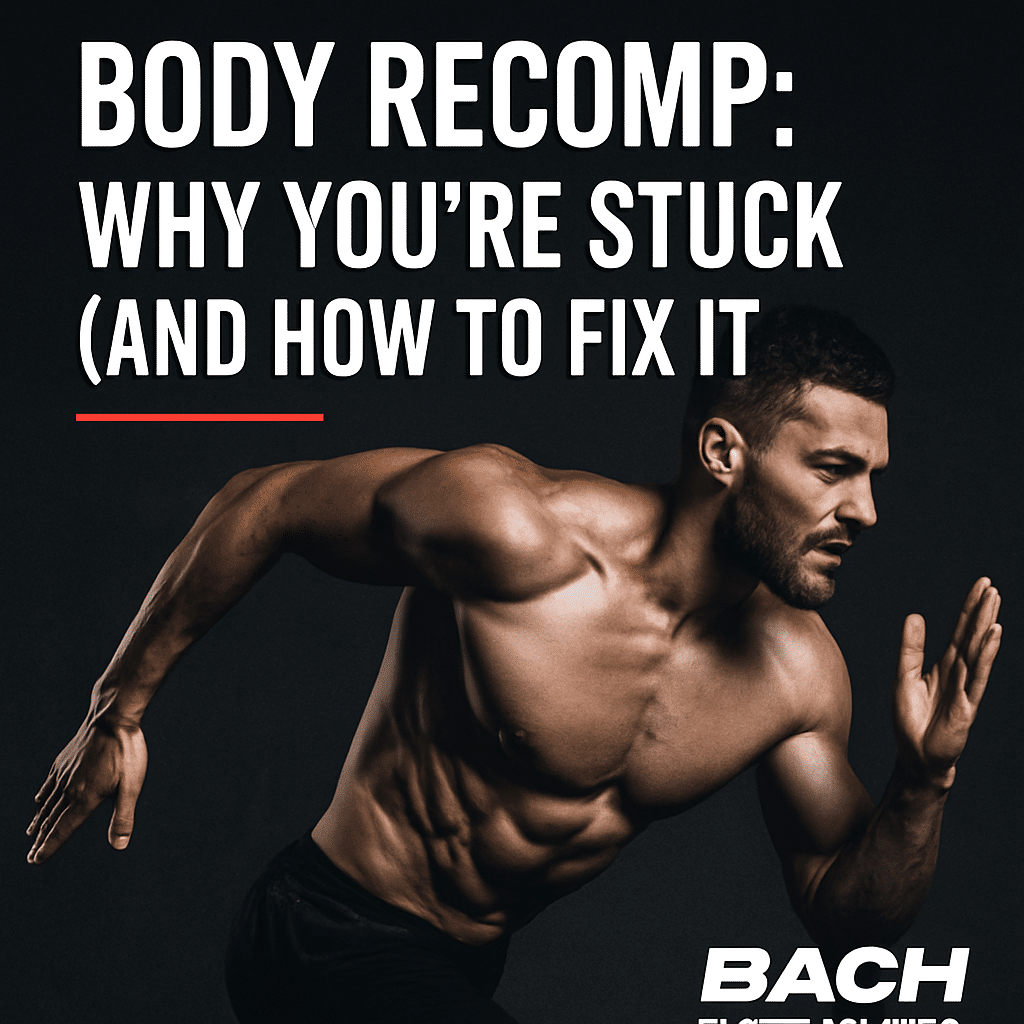Why 3 Sets of 10 Doesn’t Work (And What To Do Instead)
September 11, 2018
Guest Post By Bach Performance Coach Jorden Pagel
The ‘bro favorite of 3 sets of 10 gets real old, real fast for guys on a never-ending quest to become rhino-jacked, dyck-skin shredded, or mastodon strong.
You stop making progress and start getting frustrated.
You kinda/sorta know you need to train in a wider rep range to build an elite, sexy, eye-popping physique you love looking at in the mirror — instead of feeling like a lumpy bag of spoiled milk.
So you wonder what to do when the traditional set and rep schemes stop paying the same dividends they did when you first started training.
Do you keep pushing, trying to eek out all the gains you can get?
You could. But it would probably be a mistake.
Rather than continue to get bigger and stronger, you’re most likely going to start to wear down. Progress will slow. You may even get injured.
Why You Need to Change Your Approach
The longer you’ve spent training, the more you’re going to have to tweak your training program in order to see results. It has nothing to do with the ridiculous idea of “muscle confusion” and everything to do with avoiding plateaus that can happen as your body adapts to the same methods and movements.
Forcing new stimulus on your body forces change. Your muscles will grow bigger and stronger. And you’ll burn more calories.
I know because I’ve been there.
For several years, I didn’t make much progress. I’d show up at the gym, follow my plan for the day…and that was about it. My body composition didn’t change much. I’d chase the same 20-30 pounds on my deadlift, over and over again.
I had stagnated.
But I still wanted to gain muscle and lose fat. I didn’t progress again until I hired an experienced and smart Canadian bodybuilder to program my workouts.
The methods my coach included in my program weren’t new or magical. They have been used by bodybuilders for decades.
But the methods were new to me. I started using them consistently.
And I went from stuck to #rhinojacked.
Here’s how.
Next-Level Tactics for Becoming Rhino Jacked, Dyck-Skin Shredded, and Mastodon Strong
Drop Sets/Mechanical Advantage Drop Sets
Drop sets are a tried-and-true bodybuilding method that can help you get more out of an exercise, exhaust your muscle fibers, and burn more calories.
The concept is simple. Perform an exercise until you can’t perform any more reps with good form. Then immediately, drop the weight by about 20% or so, and perform another set to failure with the new weight. This is known as a double-drop set. To push it even further, you could drop the weight again, and perform another set to failure; making it a triple-drop set.
A traditional drop set may look like this, using barbell bicep curls as an example:
Sets 1-3 – 80 pounds for 8-12 reps (the last set should be close to or at failure)
Drop Set 1 – 65 pounds for as many reps as possible
Drop Set 2 (optional) – 55 pounds for as many reps as possible
Mechanical Advantage Drop Sets are a bit different in that you’re not performing the exact same exercise in each drop set. Instead, you’re varying the exercise slightly, to help you gain a mechanical advantage.
Our muscles move on a system of levers and pulleys, with our muscles being stronger on certain exercise variations than others. Mechanical advantage drop sets move you from the weakest variation of an exercise to the strongest.
A classic example of this are pull-ups. A pull-up mechanical advantage drop set may start with wide-grip pull-ups because it’s the weakest mechanical position; then move to medium or parallel grip pull-ups, and finish with close-grip pull-ups or chin-ups because that’s the position of strongest mechanical advantage for most people.
In each set, you’ll be performing as many reps as possible. Each subsequent exercise variation allows you to perform more reps as you move to a stronger mechanical position.
Another example of this could be incline dumbbell bench press, to flat dumbbell bench press, to decline dumbbell bench press.
Mechanical advantage drop sets make great finishers.
Rest-Pause Training
Rest-Pause style training is a great way to push past fatigue and increase training volume, without reducing the weight.
It works like this: Pick a compound exercise in your routine. After your final set, rack the weight for ten seconds, then perform as many more reps as you can with the same weight. Rack the weight for ten seconds again, then perform another set for as many reps as you can.
Continue in this fashioned for as long as you want, until you hit form failure, or you’re only performing singles.
With Rest-Pause, you’re actually pushing past failure in order to add more volume. But you won’t sacrifice weight. What makes this so great for massive gains? You’re increasing the metabolic cost.
Cluster Sets
Cluster sets are similar to Rest-Pause in that you’re resting between reps in order to increase training volume. But they are different because they’re typically performed for lower reps with a much higher weight.
Training volume is the number one driver of progress, be it for strength or size. If your goal for a session is to hit a muscle group for 32 total reps, you could use a 4×8 loading scheme, or you could perform a 4×2+2+2+2 cluster set, with 10-15 seconds rest every 2 reps.
Both schemes are going to put you at 32 reps. However, the cluster set is going to lead to much higher volume, due to the built-in rest every few reps. This allows your muscles a brief recovery.
Cluster sets are great for size and strength because they allow you to move near-maximal loads for higher reps, thus increasing the training volume.
Here’s an example of a cluster set for a barbell squat or deadlift:
Sets/Reps: 4×2+2+2+2
Rest Between Reps: 15 seconds
Rest Between Sets: 2-3 minutes
% of 1-RM: 80-90%
Partial Reps
Partial reps are a great tactic for helping increase both strength AND size.
With getting stronger, we all have the portion of a movement where we’re the weakest. With the squat, it’s at the bottom for most people. With the bench press, it’s coming off the chest.
Training specifically in the partial range of motion where you are the weakest can help you move past sticking points, and increase strength.
Partials are also great for keeping constant tension on a muscle.
There inevitably comes a point in every movement where the target muscle stops shouldering most of the load, and other muscles start to take over. For most movements, this happens at lockout or the top- and the bottom-most portion of the lift. By avoiding these positions, and utilizing 70-80% range of motion, you keep the targeted muscle doing a majority of the work.
Partials are best used in conjunction with full reps. If you’re performing sets of 10 on the shoulder press, complete 10 full range of motion reps, followed immediately by 10-15 partials with the same weight.
Another great, and brutal way to utilize partial reps, is mid-rep, like these 1 ¼ rep squats.
Cheat Reps
Cheat reps are done in order to continue performing reps past form failure by utilizing momentum or extra body movement to help move weight past a sticking point.
Cheat reps, when used sparingly and correctly, can be a great way to help build muscle. You’ll either add extra reps to the end of a set or allow yourself to complete a full set with heavier weight than you would normally use with strict form.
Cheat reps should never be used with heavy weights and low reps.
Slow Negatives
There are three main portions of a movement. There’s the concentric portion (where you’re lifting the weight) the eccentric portion (where you’re lowering the weight) and the pause that occurs between the two.
The eccentric portion is the part of the movement that causes the most muscle damage and is responsible for the most growth. It’s also the part of the where you’re strongest, so increasing the time in this portion of the movement can lead to massive gains.
Negatives can be done a couple different ways:
* By performing just pure negatives. Use a heavier weight, and a spotter or other assistance to get into the starting position or as part of a full-complete rep
* By performing the concentric and pause portions of the movement as normal, then add a 4-5 second eccentric, like these negative pull-ups.
Negatives are great for maximizing muscle damage, but be warned: they are intense.
Varying Angles
Muscle contractions occur at the particular angle that those muscle fibers run. But not all fibers of a muscle run in the same direction. This is why varying angles on exercises is so critical.
If you consistently perform the same exercise, you’ll build strength and size in that particular part of the muscle. But that doesn’t mean the entire muscle is getting stronger or bigger.
By hitting muscles at different angles using slight variations of the same exercise, you’ll create balance and strength across the entire muscle. This also helps keep joints healthy.
For example, the overhead tricep extension (shown first) hits the long head of the tricep, whereas the rope pushdown (shown second) focus more on the lateral head of the tricep.
Isometric Holds
Of all the next-level tactics I’ve had programmed into my training the last several months, isometric holds are by far my favorite. Nothing induces a sleeve-stretching, vein-popping, heart-racing pump like these.
One of the biggest keys to getting the most out of an exercise is the mind-muscle connection, or how well you can “feel” your muscle(s) working during an exercise.
The better the mind-muscle connection…
The more tension you can create during a lift…
The more muscle damage will occur, and…
The better your progress.
My favorite ways to perform holds are either at the peak contraction, or the peak stretch position.
Holding at peak contraction puts an incredible about of stress on the muscles. It greatly increases the mind-muscle connection by allowing you to “feel” the muscles working because of the activation of additional muscle fibers.
And the more you can increase the time under tension and number of muscle fibers activated in an exercise, the better.
These holds are best-performed mid-rep, between the concentric and eccentric portions of a lift, for a couple seconds. Or do them during your final rep of a set for as long as possible.
The other type of hold is typically referred to as loaded stretching. This is performed in the exact opposite position of the contraction when the muscles being worked at peak stretch. (Think: a straight arm during a bicep curl.)
This is something that Arnold used to do in his training sessions. At the end of his workouts, he would hold the bottom position of a fly to drive more blood into his pecs. And it turns out, there’s some science to back this up.
Loaded stretching emphasizes the eccentric portion of the lift where the most muscle damage occurs. The more muscle damage, the higher the rate of protein synthesis and the greater your gains.
Loaded stretches also limit the amount of blood that can enter the muscles, leading to an accumulation of lactic acid build-up. This build-up facilitates the release of key muscle building hormones, and when you release the stretch position, fresh, nutrient-rich blood enters the muscles, priming them for growth.
Try this: Perform an incline dumbbell curl for 15 total reps. However, ever 5 reps you’re going to pause in the bottom, stretch position for ten seconds.
Try not to cry!
The Takeaway
These tactics, while tried and true, should not come at the expense of the basics.
Don’t try to walk before you can crawl.
Build a solid foundation by mastering the fundamentals, then sprinkle these tactics in, and take your progress to the next level.
If you’re a man or a woman who wants to build an elite-level physique, download my 4-Week Power Look training program, and start building a head-turning physique, with the strength and performance to match.
About The Author
 Jorden is the owner of Jorden Pagel Fitness, and coach at Bach Performance. After losing over 80 pounds himself, Jorden now specializes in helping men and women take their training and nutrition to the next level, to help them build the body of their dreams. When he’s not working, he can be found at the local coffee shop sipping espresso, or at the gym training legs.
Jorden is the owner of Jorden Pagel Fitness, and coach at Bach Performance. After losing over 80 pounds himself, Jorden now specializes in helping men and women take their training and nutrition to the next level, to help them build the body of their dreams. When he’s not working, he can be found at the local coffee shop sipping espresso, or at the gym training legs.










[…] Why 3 Sets of 10 Doesn’t Work and What to do Instead By Jorden Pagel for Bach Performance […]